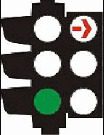Explanation:
When entering a driveway or property, a car may cross an unbroken line if it is safe to do so.

Explanation:
It is illegal to drive through a red light.
The correct answer:
The vehicle has to cross the lane line
Explanation:
The emergency car will usually pass if you move to the left, but check your mirrors to see where it is coming from.
Explanation:
Stop, double-check that it's safe to continue, and then turn left.
Explanation:
Make sure you check your mirrors and look over your shoulder before signaling your intentions so other drivers can see you.
Explanation:
Before going, always double-check both directions.
Advertisement
Explanation:
The road has a double line, but the side of the purple car has a broken line, allowing for overtaking and turning into a driveway or side street.
Explanation:
There are no red lights prohibiting you from turning left or right, so if it is safe, you may do so.
Explanation:
For instance, you must stop if a traffic police signals for you to do so at a green light. You must obey the officer's order to proceed through a stop sign or red light. Police officers, fire police, flaggers in work zones on the highway, and those at school crossings are among those with the authority to guide traffic.
Explanation:
Most intersections allow you to turn right on red if the way is clear after stopping. You must not turn on red when a "NO TURN ON RED" sign is displayed at an intersection.
Explanation:
RED ARROW. Stop is indicated with a red arrow. Wait for the green light or green arrow before continuing. When facing a red arrow, do not turn.
Explanation:
To regulate traffic, special lights may also be positioned directly over lanes of travel. These signals indicate which lanes of a street or highway should be utilized in which situations. You are allowed to utilize the lane indicated by a steady downward green arrow over a traffic lane.
Explanation:
If the traffic light is horizontal, the red light is always on the left, and if it is vertical, it is always at the top.
Advertisement
Explanation:
If you see a sign that reads "DIVIDED HIGHWAY," it implies that the route you are on crosses over a divided highway that has a guide rail or a median. Remember that you can only turn right at the first roadway and you can only turn left at the second roadway if you need to merge onto the divided highway.
Explanation:
A white stop line and/or two parallel lines may be painted across the road at an intersection when there is a STOP sign, YIELD sign, or traffic light. It's a crosswalk here. You must stop before you reach the stop line, if there is one, or the crosswalk when you are compelled to do so by a sign or light. If a light, sign, or traffic police signals you to stop at a stop line or crosswalk, or if the crossing is marked or unmarked, you must yield to pedestrians, in-line skaters, or scooters.
Explanation:
If you don't check in your mirrors and over your shoulder, you can miss a car in your blind zone. If you don't signal in time, other drivers might start a maneuver that contradicts with yours.
Explanation:
Before moving forward at an intersection, have a look to both sides. At crossroads, accidents frequently occur, so exercise caution and always put your safety first.
Explanation:
These are warning signs that point towards the general direction of the curve.
Explanation:
Any vehicle that has stopped or is stopped at a crossing may not be passed. Don't pass a stopped car even if you can't see the pedestrians because it has probably stopped so they can cross.